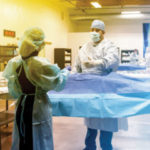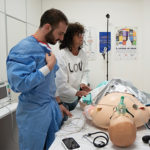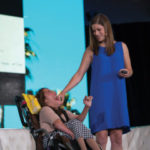
Health-care digital-marketing consultant Len Starnes on the demise of the old paradigm for medical conferences — and the birth of a new model that drives year-round engagement with members.
For decades now, medical societies have treated the annual meeting as the year’s biggest point of engagement with members. It’s the time for networking, education, and sharing research — until the following year’s meeting.
But in this age of never-off connectivity, that old paradigm is defunct, according to Len Starnes, who has created a provocative online slide presentation called “The Medical Conference Is Dead, Long Live the Medical Conference.” Starnes is the founder of Len Starnes Digital Healthcare Research & Consulting and the former head of digital marketing and sales at Bayer Healthcare Pharma in Europe. Starnes, who lives in Berlin, has worked in pharma e-marketing for more than 17 years, and has been called a “digital marketing pioneer” by industry peers.
So why does he think the medical conference is dead-but-not-really? And what does that mean for medical meeting professionals?
Your background is in digital marketing for pharmaceutical companies. How did you get interested in the future of medical conferences?
More by accident than intent. One of my pharma clients was interested in a particular medical conference, and I noticed that the conference did not have a hashtag, so I set one up. When I informed the medical society, they were not happy and told me to delete it. That got me thinking: Are all medical conferences this restrictive around social media? I started reaching out to different medical associations and found several that were exploring social media and rethinking their conferences, such as the European Society of Cardiology [ESC], the European Cancer Organisation, and the European Respiratory Society.
Why do medical societies in particular have such a hard time with people tweeting at their meetings?
Medical groups, doctors, and pharmaceutical companies tend to be conservative, and there’s been a reluctance to embrace Twitter and social media in general. Many people don’t see the point, and there’s also the issue of so-called “booth spam” and, more importantly, people tweeting preliminary or unofficial results for research announced in presentations at the meeting. At the ESC 2014 conference, I was given the opportunity to train a couple dozen medical students on how to use Twitter throughout the conference. It was exciting to have people around the globe following the conference via Twitter, and sending in questions for experts at some of the sessions. The number of tweets related to the conference jumped 300 percent compared to the year before. However, the percent of cardiologists participating was disappointing. The good news is that overall there’s been a tremendous increase in tweets from health-care conferences in recent years, and that number is growing exponentially.
Bigger picture, there’s a push from many quarters for the dissemination of medical advances to happen more quickly. On average, it takes two years before your local doctor applies new medical techniques or breakthroughs that might have been first announced at a conference. There’s a lot of discussion about how that process needs to happen faster, and how social media can play a role by facilitating discussion and dissemination of ideas in real time.
You say in your slide presentation “The Medical Meeting Is Dead” that the new frontier for medical societies is digital engagement of members throughout the year. Can you elaborate?
Medical societies are finding that younger members are less likely to be loyal, less likely to perceive the society as a primary source for information, networking, and education. They’re digital natives, people who grew up using the Internet. They are used to going online when they need answers. I think this quote from 33 Charts, the blog written by Bryan Vartabedian, M.D., an American doctor and teacher who is considered one of health care’s most influential voices on social technology and medicine, captures this point: “What constitutes a meeting today? The way doctors once related was episodic and isolated. We would come, then we would go away. Now we’re engaging, now we’re not. Until we meet again. Now the meeting and the conversation never really end, and our engagement is increasingly continuous.”
Can you give an example of year-round engagement?
The ESC Congress 365 is a good example. This resource gives ESC members free access to ESC Congress content all year long, including thousands of webcasts, slides, abstracts, and reports. Many more people visited ESC Congress 365 during the year than the number who attended the actual annual meeting. I believe hybrid conferences, where the live event has a virtual component, will increasingly become the norm, with far greater growth in virtual audiences than attendees at the live event. The reason is that as the cost of meeting participation continues to climb, and new pharma regulations and restrictions are already beginning to erode revenue streams for medical conferences, leading societies are looking at digital platforms for delivering education and networking year-round. Of course, the live meeting is not going away, but I think we’ll see more growth on the virtual side.
How could a hybrid model be used by the societies to at least support new revenue streams?
One option is for medical societies to create their own social networks for members. The success of Doximity together with more than 130 similar networks worldwide shows that this type of platform is something doctors are really looking for. [Editor’s note: Doximity, a free social network for physicians, claims that 50 percent of U.S. doctors are now active users. Doctors can use Doximity to collaborate on cases, further their careers, and stay up-to-date on specialty-specific news.] Medical societies could set up their own social networks and one could imagine, for example, on these social networks, virtual pharma booths that are accessible 365 days a year. Another source of income might be pharma-sponsored virtual and collaborative symposia. There are, of course, compliance concerns around these models, but it’s definitely something that I think will be worked out and put into effect in coming years. I know several pharma clients who would be very interested in exploring this approach.
In what other ways is the paradigm changing for medical meetings?
The “sage-on-stage” format is one that people are really tired of. People are looking for more opportunity for deep discussion with experts and with one another. One format that has really worked well for ESC is its “hub” area, which has highly interactive sessions for several hundred people. Overall, I think in the future we will see more input from attendees in building collaborative conference agendas. And I also am absolutely certain that in the near future we will see more patient tracks offered at medical meetings. There is a huge movement towards collaborative medicine, where patient experience and insights are embraced. And this will bring a new and vital dimension to medical conferences, and no doubt, challenges, too.



